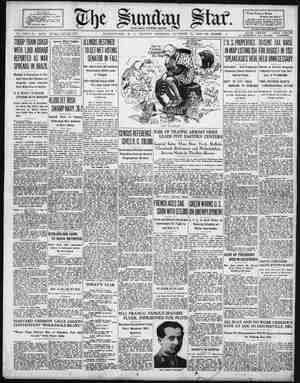Evening Star Newspaper, October 12, 1930, Page 94
You have reached the hourly page view limit. Unlock higher limit to our entire archive!
Subscribers enjoy higher page view limit, downloads, and exclusive features.
P CONMDEY YRR, WASHINGTON, YL & DCTOBER 12, 10 Early Temperance Organizations John R. Mahoney, pioneer temperance worker, still active in the cause. BY JOHN CLAGETT PROCTOR T was probably not intended that we mortals should be contented. Indeed, we find justification for this reasoning in the efforts made for many years by the various temperance organizations throughout the United States to have a prohibi- tion law put on the statute books, and now, after being part of the Constitution for nearly 11 years, there is a strong effort to have it abolished, and if such effort should prevail, then in a short while, no doubt, there would be another effort made to have it re-enacted into law. And so it goes. There are few temperance organizations at present in the city, nearly all of them having gone out of existence, though less than half a century ago there were quite a number here. They were very wide awake and active, too, and in many instances had among their mem- bers some of the foremost citizens of the Dis- trict, who.did much toward reclaiming many a man and starting him again along the right road. True, some of those who belonged to these Mnmvumwhummmeemy days of temperance bodies here a dis- tinction was made between distilled and fer- mented drinks, as in the constitution of the Pranklin Temperance Soclety of Washington, havlng.mhenh!pehldbo!winten,'hk:h TR it ssEEE 2 §§ Washington Had Many Societies Devoled to This Cause and They Had Large Enroll- ments—IHow Their Work Continued Over the Years Preceding Prohibition. Interest Shown by Congress. Old Temperance Hall, 914 E street northwest, later Marini’s Dancing Academy, corner stone laid 1843, occupied 1847. NATU‘R.ALLY. of interest are the names of those Washingtonians who represented their respective societies at ghe forming of the Tem- perance Union of the District of Columbia, now closely approaching 100 years ago. They were: Washington City Temperance Society.—Dr. Thomas Sewall, Rev. Dr. Laurie, Andrew Coyle, Charles H. Wiltberger and John Coyle (Rev. Mr. Sargent, alternate for Dr. Sewall). Union Temperance Soclety of Washington.— Ulysses Ward, J. C. Dunn, R. Middleton, R. Orme and F. Howard. Young Men's Total Abstinence Society of Washington.—R. P. Anderson, Z. W. Denham, Daniel Campbell, James Brown and Michael Larner. Navy Yard Total Abstinence Society.—W. W. Lowe, Willilam S. Walker, William Speiden, William Martin and Thomas O. Summers. Georgetown Temperance Society.—James L. Edwards, Samuel McKenney, John S. Nevins, Paul Stevens and B. M. Miller. Temperance Society of the Methodist Prot- estant Church, Georgetown.—Paul Stevens and Joel Brown. Alexandria Temperance Soclety.—T. Smith, H. Stringfellow, C. F. Lee, J. Vanzant and John ‘Withers. Temperance Society of the Methodist Epis- copal Church, Alexandria.—William Veitch, Benoni Theat, John Wood, Benjamin Waters and Dr. Joseph Wheelwright. Rock Creek Temperance Society.—Rev. C. Eastern Temperance Society of Washington. —William Doughty, sr.; James Priend, George H. Grant, Thomas Blagden and Willlam Doughty, jr. Tenleytown Temperance Society. — Joseph Foreman, George Shoemaker, Aza Gladman, Daniel Lightfoot and John Harry. As early as July 4, 1835, we find this supreme body meeting in the Methodist Church in Alexandria, then a part of the Dis- trict of Columbia, at which time the officers for the ensuing year were selected and the managers for the union decided upon, as follows: John Shackford, president; Marmaduke Dove, first vice president; Thomas Turner, second vice president; Benoni Wheat, third vice president; John Coyle, corresponding secretary; Flodoardo Howard, recording secretary, and Z. W. Den- ham, treasurer, Managers: Washington City Temperance Society.—Rev. Sewall. Dr. Laurie and Dr. Young Men’s Total Abstinence Temperance ‘Temperance Epls- copal Church, Alexandria.—Wiliam Veitch ang B. Waters, George! Hyde and B. Miller. Temperance Soceity of the Methodist Prot- estant Church, Georgetown.—P. Stevens and Joel Brown., Rock Creek Temperance Society—Rev. C. ‘Wiltberger and W. Berry. Tenleytown perance Society. — George Shoemaker, Tnmmum-mmmnm Chief Justice of the District Court, D. C. Tnljlmleelnhhnplynveapflnudm and more of figures, which would mean nothing 3 the closing paragraph of his - ‘Alexander “Bud” Eagleston, pioneer temperance worker of Washington. At this period Francis Scott Key, author of “The Star Spangled Banner,” was the United States district attorney for the District of Co- lumbia, and was called upon for a report on the criminal cases prosecuted by him and their bearing in relation to drunkenmess. After giv- ing the information requested, he concluded by saying: G 2 “This will show what the United States pays annually in Washington County in the prose- cution and punishment of crimes. I am confi- dent that a vigilant police and the suppression g: dram shops would diminish it at least one- 1f. “Hoping that your society may succeed in convincing our citizens that it is their duty and , interest to adopt these measures.”
